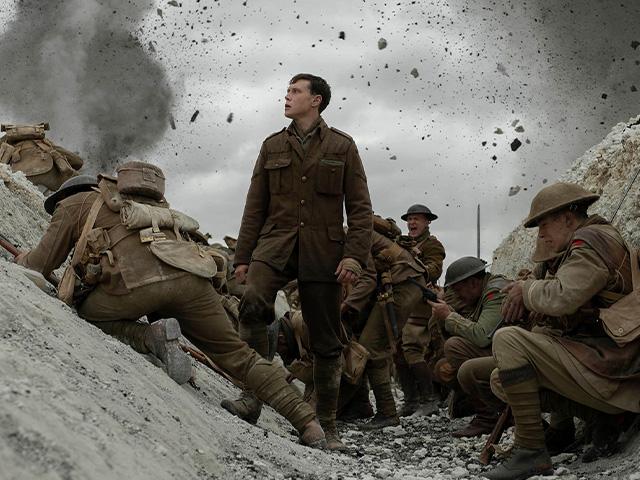1917: Movie Review

Movie Info
MPAA RATING: R
(for violence, some disturbing images, and language)
GENRES:
Drama
RELEASE:
January 10, 2020
STARRING:
George MacKay, Dean-Charles Chapman, Mark Strong, Andrew Scott, Benedict Cumberbatch, Colin Firth
DIRECTOR:
Sam Mendes
STUDIO:
Universal Pictures
Quite simply, 1917 is a prime example of masterful filmmaking. Sure, the World War I drama is filled with a great amount of hand to hand combat, plenty of explosions, and the bleakly stark realities of war, but Director Sam Mendes (Skyfall, Spectre) and cinematographer Roger Deakins (No Country for Old Men) have cleverly crafted a brilliant feat of cinematography. They have shot the movie in such a manner that it appears be one continuous, un-edited shot. In doing so, they take what could easily be a large, sprawling movie and make it feel intimate and small.
In reality, 1917 is comprised of roughly nine or ten shots meticulously and strategically planned that follow two young British soldiers on a mission to deliver a general’s urgent message calling off an impending attack. Along the way, the duo must weave their way through every war-torn obstacle imaginable: pockmarked-scarred earth, hastily dug mud-filled trenches, abandoned farmhouses, and scores of soldiers – some kind, others hostile.
1917, which has already won this year’s Golden Globe for Best Drama and Best Director (Mendes), stars two relatively unknown actors, George MacKay (Captain Fantastic) and Dean-Charles Chapman (Game of Thrones). Oscar-nominated Benedict Cumberbatch (The Imitation Game) has a small role as a British colonel preparing his troops to attack the Germans and Oscar-winner Colin Firth (The King’s Speech) plays the general who assigns the young soldiers to deliver the cease-fire message.
THE MOVIE IN A MINUTE
With the end of World War I nowhere in sight, two young British soldiers barely out of their teens, are given orders to deliver a critically important message that will potentially save more than 1,600 soldiers’ lives, including one of the chosen’s own brother. With less than 24 hours to convey this information to the proper authorities, the pair must cross through enemy territory alone, with only the aid of each other to deliver them safely. With perils and pitfalls at every turn, their trek becomes a negotiation between life and death.
THE GOOD AND BAD OF 1917
Mesmerizing for its technical wizardry, the decision to use the “continuous shot” approach is riveting in that it boils down the enormity of war into the intimacy of numerous life or death moments. Viewers will feel like they are right there in the middle of the action with the young soldiers. Subsequently, this provides a far more intense flavor for the emotions they are feeling on screen. However, one drawback is that some audiences will become distracted in trying to figure out when one shot ends and a new one begins.
Mendes’ decision to cast little-known actors in the lead roles is brilliant because it forces audiences to immerse themselves more deeply into the story. Gone is the tendency to lose focus by thinking of a big-name actor as a larger than life presence.
MacKay (Cpl. Schofield) and Chapman (Cpl. Blake) work very well together on screen, effectively displaying the dire circumstances their characters have been placed in. MacKay in particular, seems larger than life at times due to the arresting earnestness of his physical posture and facial expressions.
One bleakly beautiful moment that features MacKay poignantly illustrates the horrors of war. Fleeing from an enemy soldier trying to gun him down, his character ducks into the basement of a burned out, abandoned house. He believes he is alone but soon discovers a young woman with a baby watching him from the shadows. Initially fearful of each other, they slowly come to realize that they are allies, not enemies. But within moments of exiting her secret home, he is forced to kill an enemy soldier. Life and death in the span of five minutes.
One remarkable thought to ponder from 1917 is the extreme lack of communication that was available to military forces just a century ago. Today, an urgent message of this sort can be instantly communicated to the front lines through a myriad of technological means. In World War I, military intelligence was limited to shooting flare guns, dropping messages from bi-planes, and in this case, sending two frightened young soldiers through the heart-pounding fury of war.
Faith-based audiences should be warned that 1917 is rife with profane language not uncommon due to the extreme intensity of battlefield conditions. Also, Cpls. Schofield and Blake must sift their way through a tragic, war-torn expanse littered with dead bodies, bloody wounds, and more rats than you can count.
IN THE END
1917 is a strong testament to the valor and bravery of two very ordinary yet heroic young men. Taking the simple formula of following orders despite tremendously treacherous obstacles, Mendes delivers a breathless story of suspense that is extraordinary. So much so, that it deserves Oscar-consideration in coming days. Not for the faint of heart, 1917 is a gut-wrenching tribute to the sacrifices our veterans have made and are making to preserve freedom.





